Key Points
In the second quarter of this year, Filecoin's active storage transactions fell 6% month-on-month. Storage utilization increased from 23% in the first quarter to more than 26% in the second quarter, while storage capacity fell 19% month-on-month.
As of the end of the second quarter, 2,034 users had stored data sets on Filecoin, of which 518 users stored large data sets of more than 1,000 TiB, a month-on-month increase of 2%.
As of the end of the second quarter, more than 3,700 independent contracts were deployed on the Filecoin Virtual Machine (FVM); driven by token staking and leasing activities, FVM's TVL reached 63 million FIL (about US$273 million) in the second quarter, a record high.
Filecoin continues to evolve into a decentralized physical infrastructure network (DePIN), creating a decentralized storage market for enterprise adoption and supporting decentralized computing and artificial intelligence.
New data services have emerged on the Filecoin network, including perpetual storage, data privacy, and integration with Web2 and Web3 applications.
Filecoin Basic Information
Filecoin is building a hardware market - the first service is storage. Filecoin is built on IPFS (InterPlanetary File System) and uses transactions that price storage based on a provider market rather than a fixed pricing structure (https://filecoin.io/blog/posts/how-storage-and-retrieval-deals-work-on-filecoin/). A storage transaction is like a contract with a service level agreement (SLA: https://www.cio.com/article/274740/outsourcing-sla-definitions-and-solutions.html) - users pay storage providers to store data for a specified period.
To ensure data security, Filecoin uses a cryptoeconomic incentive model to periodically verify (https://filecoin.io/blog/posts/zero-knowledge-and-the-filecoin-network/) storage through zero-knowledge proofs (https://messari.io/report/the-zk-everything-report). To incentivize storage providers to participate in storage transactions, Filecoin will use the network's native token FIL as a reward. If the storage provider fails to provide reliable online time or acts maliciously on the network, it will also be punished accordingly (https://docs.filecoin.io/storage-provider/filecoin-economics/slashing/).
To retrieve data, Filecoin users pay retrieval providers to obtain data. Unlike storage transactions, which involve on-chain transactions, retrieval transactions use payment channels to settle off-chain payments, enabling faster retrieval. In addition to storage and retrieval, Filecoin aims to provide an open market where data can be run by contracting computing power, providing a more efficient alternative to traditional centralized systems.
Key protocol upgrades to enable data computing services include smart contracts (Filecoin Virtual Machine - FVM) (https://fvm.filecoin.io/) and extensions (Interstellar Consensus) (https://ipc.space/). The Filecoin Virtual Machine, launched in March 2023, will introduce Ethereum-style smart contracts to Filecoin, which will promote new use cases in areas including liquidity staking, perpetual storage, and decentralized computing.
Key Metrics
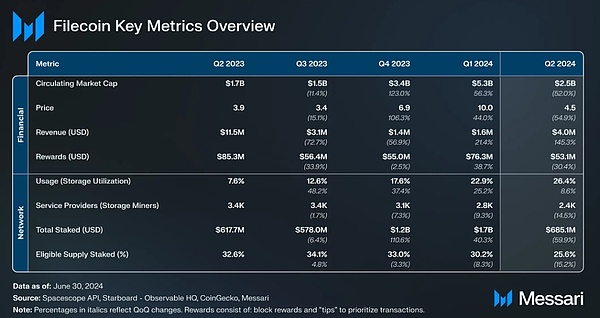
Performance Analysis
The Filecoin blockchain is used to decentralize the storage of data in the following ways:
Demand side, i.e., storage users who need data storage.
Supply side, i.e., storage providers with excess network capacity.
Network
The amount of data stored in active exchanges between storage users and storage providers measures the demand for Filecoin storage.
Storage Transactions
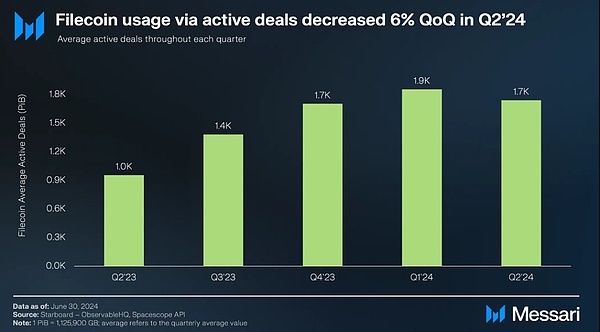
In the second quarter of 2024, more than 1,700 PiB of data was stored on the Filecoin network through active transactions, a 6% month-on-month decrease from the historical high of 1,900 PiB in the first quarter, but comparable to the level in the fourth quarter of 2023. Filecoin's current focus is on increasing enterprise applications. In June this year, Filecoin announced a new grant program (https://filecoin.io/blog/posts/announcing-onboarding-innovation-grants-program-/) to accelerate teams focused on the introduction of paid data. The program supports teams dedicated to increasing on-chain Filecoin transactions and retrieval payments and settlements, while attracting more use cases. The initiative is likely to drive an increase in active and new transactions in the coming quarters.
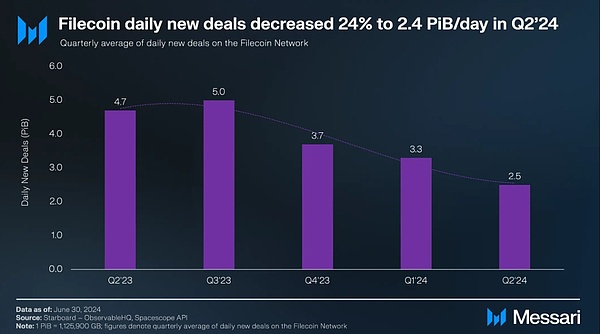
Meanwhile, daily new transaction volume continued to decline by 24% to 2.5 PiB/day after reaching an all-time high of 5 PiB/day in the third quarter of 2023. New transactions are growing on a net basis, helping to increase the utilization of the Filecoin network relative to its storage capacity.
Storage Utilization vs. Capacity

Filecoin storage utilization relative to total available storage capacity increased to over 26% in the second quarter, up from nearly 23% in the first quarter. While this growth is a positive sign for Filecoin adoption through active storage trading, it must be placed in the context of network capacity. Filecoin average raw bytes of storage capacity fell 19% quarter-over-quarter to 6.6 EiB in Q2. This metric has been declining since reaching an all-time high of nearly 17 EiB in Q2 and Q3 of 2022, about two years ago. The decline in storage capacity is further reflected in the decline in the total number of storage providers, which fell to approximately 2,400 in Q2 2024 after reaching an all-time high of over 4,100 in Q3 2022. Filecoin usage needs to be considered in terms of data-intensive activities beyond data storage. For example, platforms such as Basin(https://blog.textile.io/basin-launch-overview) and Akave(https://akave.ai/) are leveraging Filecoin’s infrastructure to provide data management and AI-related services, positioning Filecoin in the emerging AI data economy.
Storage Users
Messari Decentralized Storage Network Guide(https://messari.io/report/the-essential-guide-to-decentralized-storage-networks) shows that Filecoin is currently suitable for providing cold storage solutions (such as archiving and recovery) for enterprises and developers, and its competitive pricing helps attract traditional enterprises seeking cost-effective alternatives to store large amounts of archival data.
Data storage provider DeStor(https://destor.com/) on Filecoin recently partnered with Qamcom(https://www.qamcom.com/) DDS(https://destor.com/resources/news/qamcom-dds-destor-partnership?utm_campaign=DeStor%20x%20Qamcom&utm_content=299525148&utm_medium=social&utm_source=twitter&hss_channel=tw-1643978783375106050) to provide enhanced security, robustness, and scalability for its storage services. Partners include data users such as YayPal(https://www.yaypal.io/), a Web3 game studio whose flagship game has over 500,000 users, and Fieldstream(https://www.fieldstream.ai/), an AI marketing analytics platform.
Examples of other user solutions include:
GhostDrive(https://ghostdrive.com/): Focused on prioritizing privacy and security through encryption, decentralization, and novel storage optimization technologies.
Seal(https://www.sealstorage.io/): Focuses on providing storage services for large users such as UC Berkeley(https://www.sealstorage.io/blog/uc-berkeley-uses-web3-decentralized-storage-for-neutrino-research-data), Starling Labs(https://www.youtube.com/watch?v=sX6F9_JoxaA), Atlas Experiment(https://atlas.cern/updates/news/hllhc-data-storage) and Casper Network(https://www.youtube.com/watch?v=UkkQ5CMtTs4).
Steeldome(https://www.steeldomecyber.com/): Focuses on enterprise data archiving, backup and recovery.
In addition to cold storage, other efforts include solutions provided by companies such as Lighthouse(https://twitter.com/LighthouseWeb3/status/1477914886621458433), RIBS(https://github.com/FILCAT/ribs), retriv(https://cryptonet.org/projects/data-retrievability), and Flamenco(https://flamenco.blender.org/usage/shared-storage/).
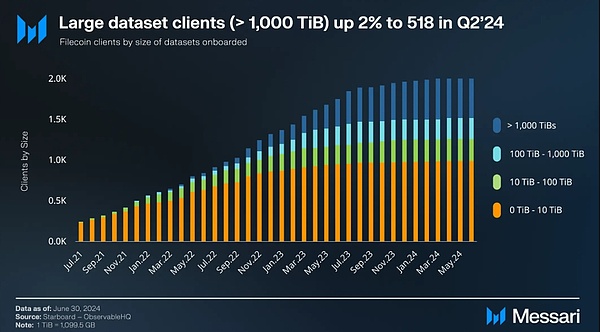
As of the end of the second quarter, 2,034(https://app.periscopedata.com/shared/d33c4430-465c-40ba-956f-76e43880eba9?) users had stored datasets on Filecoin, of which 518 users had stored large datasets (i.e., datasets with a storage size of more than 1,000 TiB), an increase of 2% from 508 in the first quarter. To encourage usage through active transactions, Filecoin provides a variety of storage services, including CID Gravity (https://www.cidgravity.com/), Titan storage (https://storage.titannet.io/), and Decentrally (https://www.decentrally.cloud/). According to Filecoin Client Explorer (https://destor.com/en-us/filecoin-network-client-explorer), major users include Starling Lab, NFT platform OpenSea (https://filecoin.io/blog/posts/opensea-decentralizes-and-persists-nft-storage-with-ipfs-and-filecoin/), and Layer-1 network Solana (https://twitter.com/triton_one/status/1681761297170325506). Other notable organizations using the Filecoin network include: Victor Chang Cardiac Institute maintains and shares research data. Democracy’s Library stores datasets collected by the Internet Archive at the end of its administration. The SETI Institute uses Filecoin to store astronomical research data.
UC Berkeley collaborates with Seal Storage on storage physics research (https://www.newswire.ca/news-releases/uc-berkeley-engages-seal-storage-web3-technology-to-advance-innovative-neutrino-physics-research-883282087.html).
GenRAIT uses Estuary to store critical genomic data on Filecoin (https://filecoinfoundation.medium.com/case-study-genrait-leverages-filecoin-network-for-greater-visibility-access-and-storage-of-1d56897a2d73).
Research center Starling Lab stores sensitive digital records of human history (https://medium.com/@FFDWeb/announcing-the-starling-lab-4f1ce0204f07).
Ewesion (China’s fastest growing graphics file host) uses Filecoin for data storage (https://filecoinfoundation.medium.com/storage-company-ewesion-leverages-filecoin-network-for-data-preservation-e36cecc84e0e).
DeSci Labs uses decentralized data storage on Filecoin to enable research to be replicated and independently verified by other researchers (https://fil.org/blog/case-study-desci-labs-and-filecoin-enabling-a-future-of-open-science/).
Opscientia (OpSci) makes it easier for scientists around the world to share data by using Filecoin (https://fil-foundation.on.fleek.co/hosting/OpSci-CaseStudy.pdf).
Destor and Seal Storage are working with Cyber SMART(https://cybersmartcenter.org/) on the AI Data Integrity Improvement Research Project, an industry-academia collaboration funded by the National Science Foundation and industry members.
Retrieval
To meet the needs of hot storage use cases, more and more Layer 2 and protocols are being built on top of Filecoin and IPFS. Examples include:
Basin(https://medium.com/@airdropking689/textile-basin-unveiled-a-storage-odyssey-for-decentralized-ai-ml-b73f907dd9bf): Focused on decentralized AI/ML.
Akave(https://akave.ai/): Provides an on-chain data lake for decentralized AI.
Storacha(https://medium.com/@storacha/storacha-x-yom-decentralized-storage-to-transform-the-depin-gaming-space-75a08544095e): Formerly web3 storage, now focusing on DePIN Gaming.
As the content distribution network (CDN) of Filecoin and IPFS, the Saturn project has completed internal testing and has now announced integration with Web3.Storage(https://filecoinproject.slack.com/archives/C04V51BHZ0W/p1715704417373819), with the goal of building a combined product and network for fast storage and retrieval. At the same time, tools such as the Station(https://www.filstation.app/) application bring decentralized retrieval capabilities to the desktop, and the SPARK(https://www.youtube.com/watch?v=aDWz3DTnOYI) and Voyager(https://twitter.com/FilecoinStation/status/1757805439410950265) modules allow retrieval checks on the network. Specifically, Station uses idle computing resources and provides FIL rewards.
FVM Usage
The Filecoin Virtual Machine (FVM) was launched in the first quarter of 2023, bringing Ethereum-style smart contracts to Filecoin. As of the end of the second quarter, more than 3,700 independent contracts (https://dashboard.starboard.ventures/fvm#total-unique-contracts-deployment) were deployed on FVM, facilitating more than 2.5 million transactions. At the same time, the TVL on Filecoin reached 63 million FIL (https://defillama.com/chain/Filecoin?currency=USD) (about US$273 million) at the end of the second quarter, a record high, mainly driven by the GLIF (https://www.glif.io/en) protocol (US$144 million), the Parasail (https://www.parasail.network/) protocol (US$58 million) and the stFIL (https://stfil.io/) protocol (US$22 million).
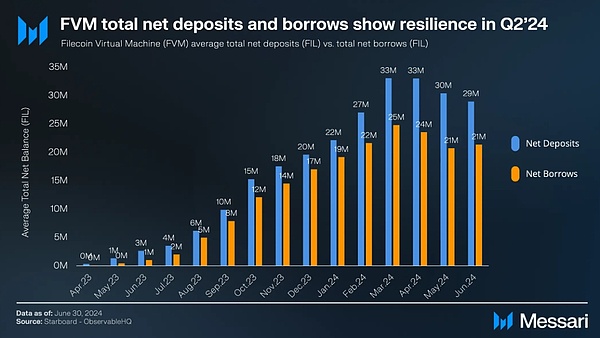
According to FVM Explorer (https://fvm.starboard.ventures/explorer), in June 2024, the average total net DeFi deposits of FVM were 29 million FIL (about 131 million US dollars), mainly used for staking, liquidity staking (https://filecointldr.io/how-to-stake-filecoin) and DEXs. Among them, the liquidity staking protocol GLIF (https://www.glif.io/en) accounted for the majority (64% as of the end of the second quarter), followed by the SFT protocol (10%) (https://www.sftproject.io/), FilFi (10%) (https://filfi.io/) and others (16%). The relevant background is as follows:
GLIF released (https://medium.com/@glifio/liquid-leasing-a-new-chapter-for-filecoin-defi-8eb52dbdb7e9) a reward program to incentivize DeFi community participation.
Parasail introduced (https://medium.com/@z1286679231/restaking-brings-new-vitality-to-filecoin-filecoin-defi-ecological-project-repl-67a2b1e82f17) a mechanism for storage providers to lock FIL and get rewards.
FILLiquid(https://filliquid.io/) proposes to provide FIL loans to storage providers(https://medium.com/@FILLiquid/three-reasons-why-filliquid-is-the-best-fil-lending-market-in-crypto-d4d9722a9638).
Thetanuts Finance(https://www.thetanuts.finance/) launched a FIL-covered call option insurance pool to earn returns.
Meanwhile, according to the FVM DeFi leaderboard (https://fvm.starboard.ventures/explorer/leaderboard), the average net borrowing in DeFi was 21 million FIL (about $95 million) in June 2024. Although both deposits and borrowing increased in the first quarter, they cooled down in April. This cooling was mainly due to the overall risk-averse market environment and the cessation of the stFIL loan program.
Financial aspects
Filecoin's revenue framework is similar to Ethereum's, as its Gas system is designed based on the EIP-1559 mechanism (https://filecoin.io/blog/posts/eip-1559-in-filecoin/). The Gas system consists of network fees, which are burned to compensate for the resources used. Both storage users and storage providers generate protocol revenue.
Revenue
According to Messari revenue analysis (https://messari.io/article/demystifying-filecoin-s-revenue), Filecoin protocol revenue includes the sum of the following four items:
Base fees - depends on the message congestion situation, any storage proof is required.
Batch fees - used when batch packaging storage proofs.
Overestimation fees - used to optimize gas usage.
Penalty fees – Penalties imposed when a storage provider fails.
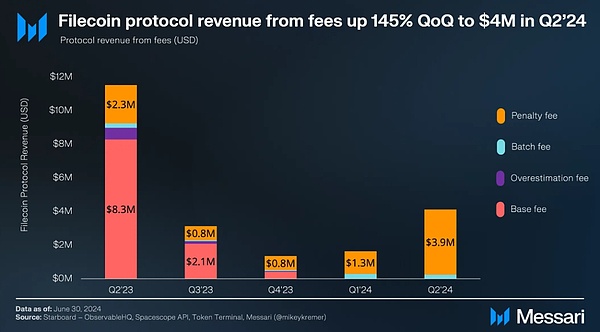
While fee revenue grew 145% in Q2 to $4 million, average raw bytes stored fell 19% QoQ, driven by increases in penalty and batch fees. At that level, penalty fees grew from $1.3 million in Q1 to $3.9 million in Q2.
Meanwhile, the base fee for storage transactions was $9,000 in Q2, consistent with the overall decline in demand-side fees charged to users in decentralized cloud storage spaces. Organizations including the Decentralized Storage Alliance (DSA) are actively working to reduce the cost of storing data on the Filecoin network (https://filecoin.io/blog/posts/dsa-reduces-decentralized-storage-costs-by-40-percent/).
Rewards
Filecoin rewards include:
In the second quarter, block rewards accounted for more than 99.9% of supply-side revenue, while "tips" accounted for only a small part. The new FIL token minting mechanism (https://spec.filecoin.io/systems/filecoin_token/minting_model/#:~:text=Baseline%20minting%20allocation%20mints%20more,of%20minting%20filecoin%20too%20quickly.) relies on the following two:
Exponential decay model (30% of total): To encourage participation, block rewards are highest in the early stage. Over time, they decay exponentially.
Baseline model (70% of total): Block rewards are distributed as storage capacity increases.
The combination of these two models helps maintain participation after the early block reward distribution phase of the network ends (see exponential decay model), and also helps to continue to reward the additional value brought to the network by the increase in network storage capacity (see baseline model).
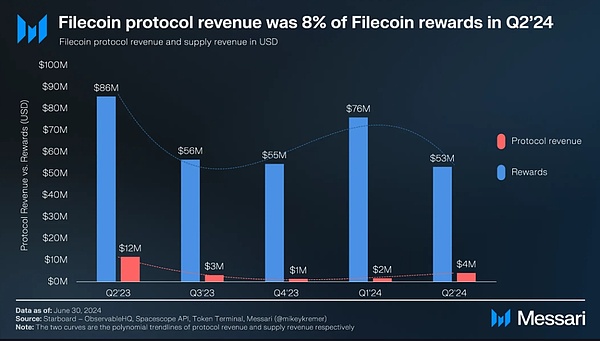
Due to the decline in FIL/USD price, supply-side rewards fell from $76 million in Q1 to $53 million in Q2, a 30% drop. For FIL, rewards fell from 10.6 million FIL in Q1 to 9 million FIL in Q2, a 15% drop. FIL reward issuance may continue to decline in the coming quarters. For an in-depth discussion and various simulations of future FIL issuance, please refer to Messari's recent research on FIL circulating supply (https://messari.io/report/cryptoecon-series-investigating-fil-circulating-supply).
Ecosystem Overview
The Filecoin ecosystem has a diverse range of application areas, from DeFi and AI to enterprise storage and DePIN. The Filecoin ecosystem (https://ecosystem.filecoin.io/?results=115) related teams have been actively developing builder channels. Many hackathons and accelerators dedicated to building on Filecoin have helped early projects and teams obtain funding from external parties and affiliated entities, including hackathon communities such as ETH Global and FilOz.
As of June 2024, Filecoin Ecosystem Explorer (https://fil.org/ecosystem/) has included more than 160 known projects (https://fil.org/ecosystem/), which is a non-exhaustive database of community network projects. Most projects using Filecoin provide data services:
Lighthouse(https://twitter.com/LighthouseWeb3/status/1477914886621458433): A permanent data storage service with a one-time payment pricing model.
Seal Storage(https://www.sealstorage.io/): An immutable data storage solution.
Steeldome(https://www.steeldomecyber.com/): Data protection and data storage solutions.
Fluence(https://fluence.network/): Enable developers to scale their Web3 projects.
Storacha(https://github.com/storacha-network): Decentralized hot storage network, focused on DePIN Gaming.
Ramo Network(https://www.web3mine.io/): Monetize idle computing power.
Bagel(http://bagel.net/): GPU refactoring and AI infrastructure.
IoTeX(https://iotex.io/2.0): Open, modular infrastructure for DePINs.
Media and entertainment focused protocols include:
Huddle01(https://huddle01.io/): Decentralized video conferencing.
OPGames(https://www.opgames.org/): Game related NFT minting.
FileMarket(https://filemarket.xyz/): Web3 store builder and marketplace.
The following use cases aim to leverage Filecoin infrastructure to drive data needs in specific areas:
Cryptosat(https://protocol.ai/blog/satellites-for-crypographic-protocols/): Use mini satellites to prevent side-channel attacks and enable secure verification.
ZKsig NFT(https://ethglobal.com/showcase/zksig-nfts-j597n): Market access control.
DataMarket(https://ethglobal.com/showcase/datamarket-instant-data-purchase-pages-zz5z0): Data purchase and settlement capabilities.
Bacalhau(https://www.bacalhau.org/): A data computing platform for running decentralized computing jobs.
Projects focused on AI include:
Basin(https://github.com/tablelandnetwork/basin-provider): Data management and collaboration, used by Tableland, WeatherXM(https://mirror.xyz/tableland.eth/jxWM36j7OaW4plfTlpQpgRrIDuth75lJhVjj0BiFwBA) network and Bacalhau(https://www.bacalhau.org/) computer network.
EQTY Lab(https://www.eqtylab.io/): Uses cryptographic methods to verify snapshots of AI model lineages, leveraging decentralized technologies such as IPFS and Filecoin to anchor model data.
SingularityNET(https://singularitynet.io/): Leading AI platform developer.
Bagel(http://bagel.net/): GPU re-staking and AI infrastructure.
Akave(https://akave.ai/): L2 storage creates an on-chain data lake.
Theoriq(https://www.theoriq.ai/): Modular and composable AI agent base layer.
Nuklai(https://www.nukl.ai/): Collaborative data ecosystem and infrastructure provider for private data networks.
Qualitative Analysis
Key Developments
Network Upgrade
V22 Dragon Upgrade(https://messari.io/intel/event/9aa7d940-1193-4098-8721-fcb397228581) was successfully implemented on the Filecoin mainnet on April 24, 2024. The scope of this network upgrade has been determined, including the following FIPs:
FIP-0063(https://github.com/filecoin-project/FIPs/blob/master/FIPS/fip-0063.md): Switch to the new Drand mainnet.
FIP-0074(https://github.com/filecoin-project/FIPs/blob/master/FIPS/fip-0074.md): Cancel Cron-based automatic transaction settlement.
FIP-0076(https://github.com/filecoin-project/FIPs/blob/master/FIPS/fip-0076.md): Direct data loading.
FIP-0083(https://github.com/filecoin-project/FIPs/blob/master/FIPS/fip-0083.md): Add built-in Actor Events to verified registries, storage providers, and market participants.
V23 Waffle Upgrade(https://github.com/filecoin-project/community/discussions/74) was implemented on August 6, 2024, introducing the following FIPs:
FIP-0065(https://github.com/filecoin-project/FIPs/blob/master/FIPS/fip-0065.md): Ignore built-in market locked balances in circulating supply calculations.
FIP-0079(https://github.com/filecoin-project/FIPs/blob/master/FIPS/fip-0079.md): Add BLS aggregate signatures to the Filecoin Virtual Machine (FVM).
FIP-0084(https://github.com/filecoin-project/FIPs/blob/master/FIPS/fip-0084.md): Remove the Storage Miner Actor method ProveCommitSectors.
FIP-0085(https://github.com/filecoin-project/FIPs/blob/master/FIPS/fip-0085.md): Convert the f090 Mining Reserve actor to a keyless account actor.
FIP-0090(https://github.com/filecoin-project/FIPs/blob/master/FIPS/fip-0090.md): Non-interactive Proof of Replication (PoRep).
FIP-0091(https://github.com/filecoin-project/FIPs/blob/master/FIPS/fip-0091.md): Add support for Homestead and EIP-155 Ethereum transactions, referred to as "legacy" Ethereum transactions.
F3: Filecoin Fast Finality
Filecoin developers announced(https://github.com/filecoin-project/community/discussions/74#discussioncomment-9866172) that the protocol specification for the Filecoin Fast Finality (F3 or FIP-0086)(https://github.com/filecoin-project/FIPs/blob/master/FIPS/fip-0086.md) program was completed in June. FIP-0086 (https://github.com/filecoin-project/FIPs/blob/master/FIPS/fip-0086.md) was proposed in December 2023 to shorten the end time of Filecoin. The specification introduces an F3 component that runs with the current consensus mechanism Expected consensus (EC) in Filecoin user nodes (participants). Due to changes in the EC fork selection rules, FIP-0086 will require a network upgrade.
Partnership
AI platform developer SingularityNET (https://singularitynet.io/) and the Filecoin Foundation are collaborating (https://medium.com/singularitynet/singularitynet-and-filecoin-foundation-collaborate-to-enhance-ai-capabilities-through-depin-6b6db3ea224a) to store SingularityNET metadata on the Filecoin network. To support archival data needs, the collaboration will also integrate the Filecoin technology stack to enhance the robustness and security of decentralized data storage.
AI base layer platform Theoriq(https://www.theoriq.ai/) and Filecoin Foundation are developing(https://mirror.xyz/0xbCAa90C8bA95b3ba6C8Aa6900a92FE70b97E5eF7/y8zj9hbr6ZEES9V9bMtqyzEBm0osh5ivoSBEYVN3mkI) a series of AI agents trained on Filecoin network data to make open data more accessible and usable. Currently, a Filecoin AI agent trained on Filecoin documentation and GitHub repositories(https://infinity.theoriq.ai/) is available for testing. The agent allows users to query answers to questions such as how to build on Filecoin, solve common problems, and how to become a storage provider through natural language. In addition, Filecoin Foundation and Theoriq are exploring an AI agent to enable efficient and verifiable research on 1 million documents using MuckRock's 25-year declassified CIA dataset stored on Filecoin (https://www.muckrock.com/news/archives/2017/jan/17/cias-declassified-database-now-online/).
Meanwhile, IoTeX DePIN Layer-1 announced (https://cointelegraph.com/press-releases/iotex-launches-20-to-upgrade-l1-blockchain-into-open-modular-infra-for-all-depins) Filecoin as the preferred storage primitive for IoTeX 2.0's modular DePIN infrastructure.
Key Governance Decisions
Storage Innovation Grants Program
In June, Filecoin announced (https://filecoin.io/blog/posts/announcing-onboarding-innovation-grants-program-/) a new program called the Storage Innovation Grants Program to drive innovation and accelerate the growth of Filecoin data storage. Funded by the Filecoin Foundation and Protocol Labs, it supports teams working to increase on-chain Filecoin transactions and retrieve payments and settlements, thereby expanding the use cases of the Filecoin network.
Summary
In the second quarter of this year, Filecoin's active storage transactions decreased by 6% month-on-month. Storage utilization increased from 23% in the first quarter to more than 26% in the second quarter, while storage capacity decreased by 19% month-on-month. Meanwhile, as of the end of the second quarter, 2,034 users had stored data on Filecoin, of which 518 stored large data sets of more than 1,000 TiB, a 2% increase from the previous quarter. Due to the decline in FIL/USD prices and a 15% reduction in FIL reward issuance, rewards fell 30% from $76 million in the first quarter to $53 million in the second quarter.
More than a year after the launch of the Filecoin Virtual Machine (FVM), as of June 30, 2024, more than 3,700 independent contracts were deployed on FVM; driven by token staking and leasing activities, the TVL on FVM reached 63 million FIL (about $273 million) in the second quarter, a record high. As FVM continues to gain attention, it will become the basis for the development of monetizable FVM use cases around data and computing.
In addition to developing the FVM ecosystem, the Filecoin community is focused on increasing enterprise applications through new funding programs. The new funding program aims to increase on-chain transactions and retrieval payments and settlements, and attract new use cases for the Filecoin network. In addition to enterprise adoption, there are more and more AI-oriented projects on Filecoin, which is expected to grow with the trend of decentralized computing.
 JinseFinance
JinseFinance








